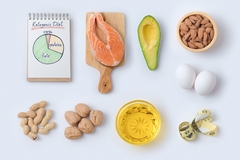Healthy Eating Messages Appear to Be Resonating With Consumers, According to New Harris Interactive Survey
A new survey by Harris Interactive(R) suggests that messages regarding the potential benefits and risks of certain foods and nutrients are resonating with consumers.

ROCHESTER, N.Y. -- A new survey by Harris Interactive(R) suggests that messages regarding the potential benefits and risks of certain foods and nutrients are resonating with consumers. Many U.S. adult consumers are aware of the impact that whole grains, antioxidants and saturated and trans fats have on one's health, whether it be positive or negative. In some cases, this knowledge has led to concerns, and in other cases it has led to actions, such as the increase in consumption of whole grains by many consumers. The survey also gives marketers some food for thought by shedding light on the types of foods and beverages consumers perceive to be healthy or unhealthy.
Below are some of the results of a recent Harris Interactive(R) study titled "Healthy Eating: Impact on the Consumer Packaged Goods Industry." The study was conducted online from January 3 to 10, 2006 among 1,040 U.S. adults.
Health warnings
Presumably, anyone who has paid attention to the media lately knows that saturated fats and trans-fatty acids are popular nutrition topics. Messages about these ingredients and the side effects of consuming them appear to have successfully educated consumers.
-- Over half (54%) of adults say they are familiar with the impact that saturated fat has on their health and 77 percent of those who are familiar say they are very or extremely concerned about the health hazards associated with this type of fat. -- Almost half (46%) of adults are familiar with the impact of trans- fatty acids on their health and more than three-quarters (79%) of those who are familiar with this are very or extremely concerned that these pose a health hazard. -- Though there is a high awareness among adults of sodium's impact on their health (70%), a message that has been around for years, health concerns about sodium are not as great when compared to today's hot topics like fats (55% of those who are familiar with sodium's impact say they are very or extremely concerned about the health hazards it poses).
"The survey reveals that consumers rely on lists of ingredients and nutritional labels a great deal when selecting their purchases," says Anne Aldrich, Senior Vice President of the Consumer Packaged Goods Research Practice at Harris Interactive. "A quarter of adults say the nutrition facts panel is of greatest importance to them when purchasing a food or beverage, making it second only to price. Food and beverage manufacturers need to take this into account when developing packaging that is designed to set their product apart from the competition."
Healthy hype
While there has been much talk about the potential health hazards of consuming certain ingredients, media hype has also centered on some healthy products consumers could be incorporating into their diets.
-- The survey suggests that the push for the consumption of whole grains appears to be working as two in five (41%) adults say they eat whole grains more often than they did last year. Almost one-third of adults cite nutritional value (32%) and increased fiber (31%) as their top reasons for choosing to eat whole grains. -- A large majority of adults (79%) buy into the notion that there is a link between mental sharpness and the type of foods people eat. However, not everyone who believes this practices what they preach, with only seven percent saying they 'always' and 60 percent saying they 'sometimes' purchase foods or beverages because they know they are rich in antioxidants.
Aldrich comments, "As we can see, consumers can articulate the health benefits of particular ingredients. Savvy marketers will want to link these benefits to their product's unique brand promise."
Soup to nuts
One of the best ways to find out how consumers internalize all of the health-related messages they receive is to observe their perception of the healthiness of particular foods and beverages. Homemade soup (77%), nuts (65%), dried fruit (62%) and fruit juices or juice drinks (47%) top a list of 24 foods or beverages measured that substantial numbers of adults perceive to be healthy. Conversely, and as one might expect, fewer adults perceive candy bars (2%), cakes/pies/muffins (2%), potato/corn chips (2%) and cookies (1%) to be healthy.
TABLE 1 FAMILIARITY WITH EFFECTS ON HEALTH "How familiar are you with the impact of each of the following on your health?" Scale: 1 to 5 where 1 = "Not at all familiar" and 5 = "Very familiar" Percent giving rating of 4 or 5 Base: All adults Total % Sodium 70 Saturated fat content 54 Trans-fatty acids 46 Antioxidants 44 Kosher status given to certain foods 19 GMOs - Genetically modified organisms 17 Prebiotics and probiotics 11 Sterols 10 Acrylamides 8 TABLE 2 CONCERN WITH POTENTIAL HEALTH HAZARDS "How concerned are you that each of these things, if present in the foods you eat, poses a health hazard?" Percent saying "extremely" or "very" concerned Base: Familiar with item (variable base) Total % Trans-fatty acids 79 Saturated fat content 77 Acrylamides* 71 GMOs - genetically modified organisms 57 Sodium 55 Sterols 52 * Small base (n<100). Data should only be used directionally. TABLE 3 MOST IMPORTANT FACTORS WHEN PURCHASING FOODS OR BEVERAGES "Which of the following is of greatest importance to you when purchasing a food or beverage?" Base: All adults % Price 30 Nutrition facts panel 24 Ingredients list 18 Brand name 6 Serving size 4 Statements about nutritional benefits 4 Statements about health benefits 2 None of these 13 TABLE 4 CURRENT WHOLE GRAIN CONSUMPTION HABITS "Thinking about your eating habits in the last year, would you say you are now eating whole grain products ... ?" Base: All adults Total % More Often (NET) 41 Much more often 8 Somewhat more often 33 No change 54 Less Often (NET) 5 Somewhat less often 3 Much less often 2 TABLE 5 PRIMARY REASON FOR CHOOSING WHOLE GRAIN PRODUCTS "What is your primary reason for choosing to eat whole grain products?" Base: All adults Total % Nutritional value 32 Increased fiber 31 Better taste 13 Reduced calories 4 Change of pace 4 Less refined grains 3 Other 5 None, I don't eat whole grain products 10 Note: Percentages may not add up to 100% due to rounding. TABLE 6 LINK BETWEEN MENTAL SHARPNESS AND FOOD CONSUMED "Do you think there is a link between mental sharpness and the type of food people eat?" Base: All adults Total % Yes 79 No 21 TABLE 7 HOW OFTEN PURCHASE FOODS RICH IN ANTIOXIDANTS "How often do you purchase foods or beverages because you know they are rich in antioxidants?" Base: All adults Total % Always 7 Sometimes 60 Never 33 TABLE 8 PERCEIVED HEALTHINESS OF FOODS AND BEVERAGES "How healthy do you perceive each of the following types of foods or beverages to be?" Scale: 1 to 5 where 1 = "Not at all healthy" and 5 = "Very healthy" Percent giving rating of 4 or 5 Base: All adults Total % Homemade soup 77 Nuts 65 Dried fruit 62 Fruit juices or juice drinks 47 Snack mixes (nuts/dried fruit combos) 45 Cheese 43 Breakfast cereals 42 Granola bars 36 Popcorn 30 Cereal bars 22 Pretzels 22 Ready-to-serve canned soup 17 Crackers 15 Meat snacks 15 Condensed soup 14 Jelly, jam, preservatives, fruit spreads 12 Frozen meals 11 Shelf-stable meal kits 5 Gummy snacks (fruit snacks/roll-ups) 5 Ice cream/frozen confections 4 Candy bars 2 Cakes/pies/muffins 2 Potato/corn chips 2 Cookies 1 Methodology
Harris Interactive(R) conducted the online study from January 3 to 10, 2006 among a nationwide sample of 1,040 U.S. adults (aged 18 years and over). Figures for age by gender, race/ethnicity, education, region, and household income were weighted to reflect the total U.S. adult population. Propensity score weighting was used to adjust for respondents' propensity to be online.
In theory, with a probability sample of this size, one can say with 95 percent certainty that the results for the overall sample have a sampling error of plus or minus 3 percentage points of what they would be if the entire U.S. adult population had been polled with complete accuracy. Sampling error for the sub-samples of those who are familiar with the health impact of sodium (753), trans-fatty acids (506), saturated fat content (575), GMO's (194), sterols (120) and acrylamides (84) is higher and varies. Unfortunately, there are several other possible sources of error in all polls or surveys that are probably more serious than theoretical calculations of sampling error. They include refusals to be interviewed (nonresponse), question wording and question order, and weighting. It is impossible to quantify the errors that may result from these factors. This online sample was not a probability sample.
















